Impact of Modeling Abstractions When Estimating Leaf Mass per Area and Equivalent Water Thickness over Sparse Forests Using a Hybrid Method
Abstract
1. Introduction
2. Materials and Methods
2.1. Study Sites and In Situ Validation Data
2.2. Trunk and Branches Structure
2.3. Airborne Hyperspectral Remote Sensing Data
2.4. Classification of Conifers and Broad-Leaved Trees
2.5. Radiative Transfer Modeling
- Section 2.7, for the sensitivity analysis:
- –
- SFR–Reference database, with a simplified forest representation (SFR) serving as reference;
- –
- variation database, with the variation cases.
- Section 2.8, to train the RFR dedicated to the synthetic image:
- –
- SFR database, with an SFR modeling;
- –
- DETAIL database, with a detailed modeling.
- Section 2.8, to train the RFR dedicated to the AVIRIS-NG images:
- –
- TZ database, with an SFR modeling, dedicated to TZ;
- –
- SJER database, with an SFR modeling, dedicated to SJER.
2.6. Synthetic Image Generation
2.7. Reflectance Sensitivity to Structural Elements
2.8. Random Forest Regressors
3. Results
3.1. Effects of Structural Elements on Crown Reflectance
3.2. EWT and LMA Estimations
4. Discussion
4.1. On the Use of Synthetic Images
4.2. Influence of the Structural Parameters on Crown Reflectance
4.3. EWT and LMA Estimations
5. Conclusions
Author Contributions
Funding
Data Availability Statement
Acknowledgments
Conflicts of Interest
Appendix A. Feature Importances of the Random Forest Regressors

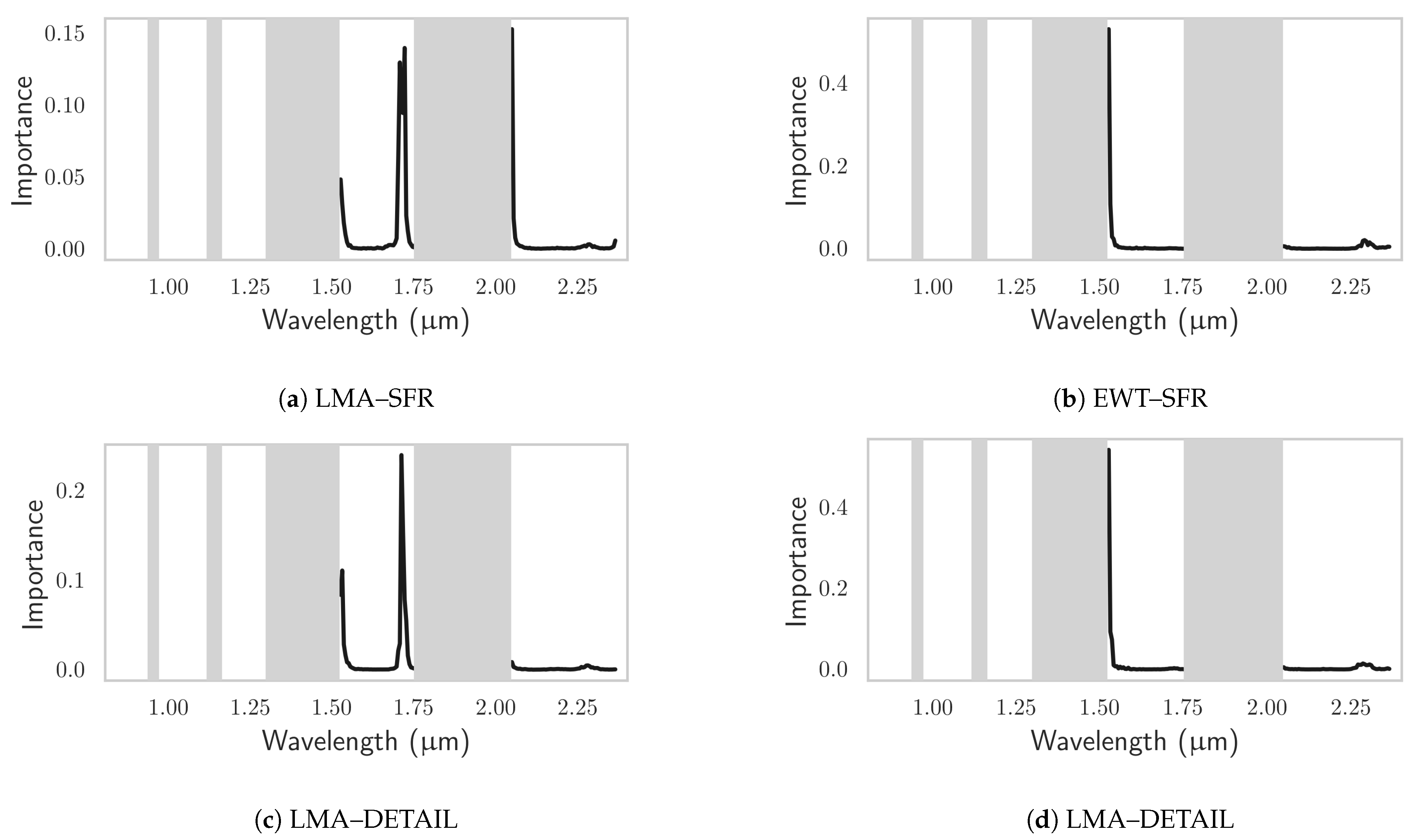
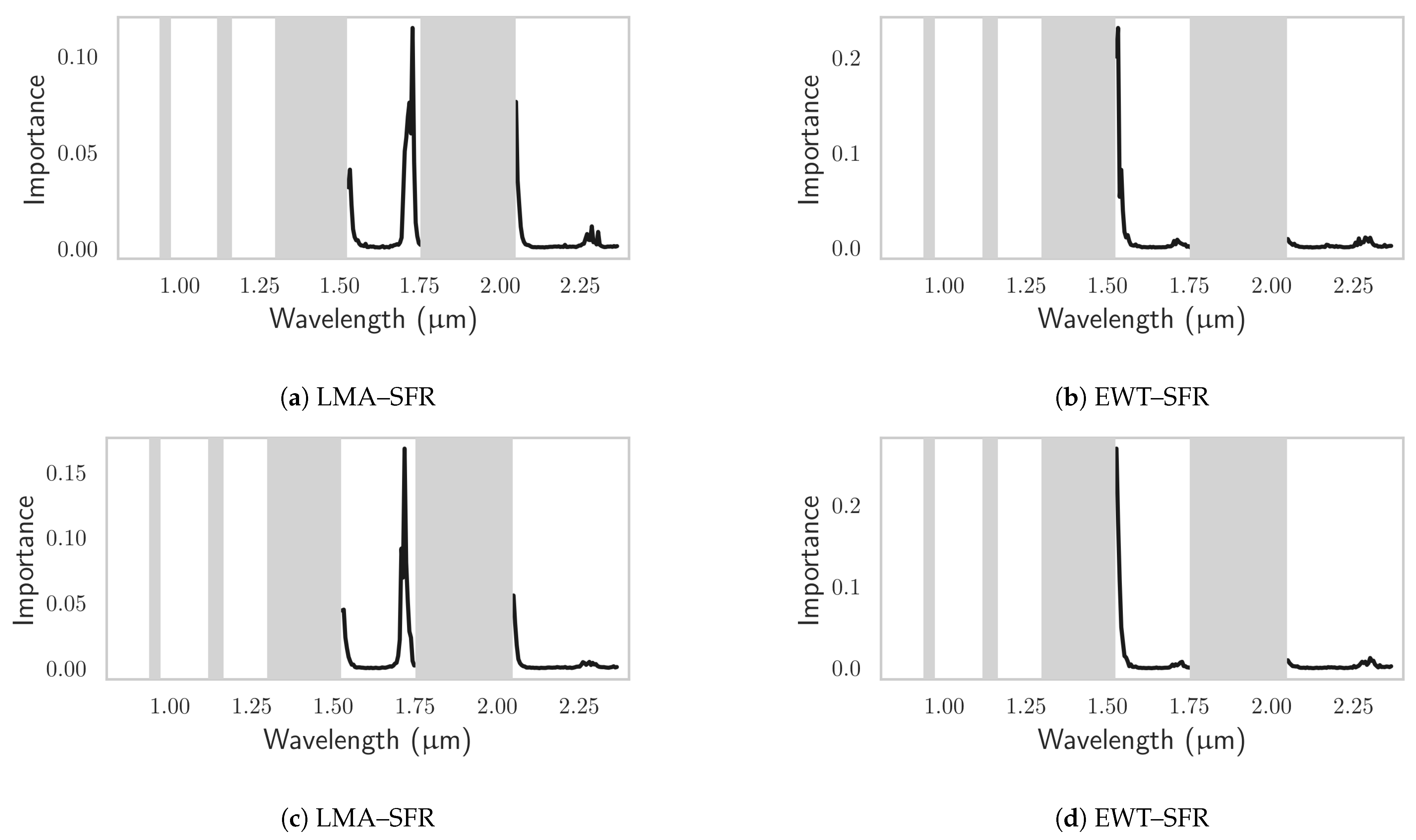
References
- Cowling, R.M.; Rundel, P.W.; Lamont, B.B.; Kalin Arroyo, M.; Arianoutsou, M. Plant diversity in mediterranean-climate regions. Trends Ecol. Evol. 1996, 11, 362–366. [Google Scholar] [CrossRef]
- Myers, N.; Mittermeier, R.A.; Mittermeier, C.G.; da Fonseca, G.A.B.; Kent, J. Biodiversity hotspots for conservation priorities. Nature 2000, 403, 853–858. [Google Scholar] [CrossRef] [PubMed]
- Jiménez-Ruano, A.; Mimbrero, M.R.; de la Riva Fernández, J. Earth Observation of Wildland Fires in Mediterranean Ecosystems; Springer: Berlin/Heidelberg, Germany, 2009; Volume 89, pp. 100–111. [Google Scholar] [CrossRef]
- Scarascia-Mugnozza, G.; Oswald, H.; Piussi, P.; Radoglou, K. Forests of the Mediterranean region: Gaps in knowledge and research needs. For. Ecol. Manag. 2000, 132, 97–109. [Google Scholar] [CrossRef]
- Sala, O.E.; Chapin, F.S.; Armesto, J.J.; Berlow, E.; Bloomfield, J.; Dirzo, R.; Huber-Sanwald, E.; Huenneke, L.F.; Jackson, R.B.; Kinzig, A.; et al. Global biodiversity scenarios for the year 2100. Science 2000, 287, 1770–1774. [Google Scholar] [CrossRef]
- Moriondo, M.; Good, P.; Durao, R.; Bindi, M.; Giannakopoulos, C.; Corte-Real, J. Potential impact of climate change on fire risk in the Mediterranean area. Clim. Res. 2006, 31, 85–95. [Google Scholar] [CrossRef]
- Skidmore, A. Essential biodiversity variables (EBV) and plant functional traits from earth observation and image spectroscopy: Powerpoint. In Proceedings of the AGU Fall Meeting 2013, San Fransisco, CA, USA, 9–13 December 2013; p. 13 slides. [Google Scholar]
- Jetz, W.; McGeoch, M.A.; Guralnick, R.; Ferrier, S.; Beck, J.; Costello, M.J.; Fernandez, M.; Geller, G.N.; Keil, P.; Merow, C.; et al. Essential biodiversity variables for mapping and monitoring species populations. Nat. Ecol. Evol. 2019, 3, 539–551. [Google Scholar] [CrossRef] [PubMed]
- Westoby, M.; Baruch, Z.; Bongers, F.; Cavender-Bares, J.; Chapin, T.; Diemer, M.; Wright, I.J.; Reich, P.B.; Ackerly, D.D.; Cornelissen, J.H. The worldwide leaf economics spectrum. Nature 2004, 428, 821–827. [Google Scholar]
- Serbin, S.P.; Wu, J.; Ely, K.S.; Kruger, E.L.; Townsend, P.A.; Meng, R.; Wolfe, B.T.; Chlus, A.; Wang, Z.; Rogers, A. From the Arctic to the tropics: Multibiome prediction of leaf mass per area using leaf reflectance. New Phytol. 2019, 224, 1557–1568. [Google Scholar] [CrossRef] [PubMed]
- Schimel, D.; Pavlick, R.; Fisher, J.B.; Asner, G.P.; Saatchi, S.; Townsend, P.; Miller, C.; Frankenberg, C.; Hibbard, K.; Cox, P. Observing terrestrial ecosystems and the carbon cycle from space. Glob. Chang. Biol. 2015, 21, 1762–1776. [Google Scholar] [CrossRef] [PubMed]
- Penuelas, J.; Filella, I.; Biel, C.; Serrano, L.; Save, R. The reflectance at the 950–970 nm region as an indicator of plant water status. Int. J. Remote Sens. 1993, 14, 1887–1905. [Google Scholar] [CrossRef]
- Penuelas, J.; Pinol, J.; Ogaya, R.; Filella, I. Estimation of plant water concentration by the reflectance Water Index WI (R900/R970). Int. J. Remote Sens. 1997, 18, 2869–2875. [Google Scholar] [CrossRef]
- Roberts, D.A.; Dennison, P.E.; Peterson, S.; Sweeney, S.; Rechel, J. Evaluation of Airborne Visible/Infrared Imaging Spectrometer (AVIRIS) and Moderate Resolution Imaging Spectrometer (MODIS) measures of live fuel moisture and fuel condition in a shrubland ecosystem in southern California. J. Geophys. Res. Biogeosci. 2006, 111. [Google Scholar] [CrossRef]
- Yebra, M.; Dennison, P.E.; Chuvieco, E.; Riaño, D.; Zylstra, P.; Hunt, E.R.; Danson, F.M.; Qi, Y.; Jurdao, S. A global review of remote sensing of live fuel moisture content for fire danger assessment: Moving towards operational products. Remote Sens. Environ. 2013, 136, 455–468. [Google Scholar] [CrossRef]
- Jacquemoud, S.; Ustin, S.L. Application of radiative transfer models to moisture content estimation and burned land mapping. In Proceedings of the 4th International Workshop on Remote Sensing and GIS Applications to Forest Fire Management, Ghent, Belgium, 5–7 June 2003; pp. 3–12. [Google Scholar]
- Yebra, M.; Quan, X.; Riaño, D.; Rozas Larraondo, P.; van Dijk, A.I.; Cary, G.J. A fuel moisture content and flammability monitoring methodology for continental Australia based on optical remote sensing. Remote Sens. Environ. 2018, 212, 260–272. [Google Scholar] [CrossRef]
- Mohammed Ali, A.; Skidmorea, A.K.; Darvishzadeha, R.; Durena, I.V.; Holzwarthc, S.; Muellerd, J. Mapping forest leaf dry matter content from hyperspectral data. In Proceedings of the ASPRS 2016 Annual Conference: IGTF 2016—Imaging and Geospatial Technology Forum and Co-Located JACIE Workshop, Fort Worth, TX, USA, 11–15 April 2016. [Google Scholar]
- Wocher, M.; Berger, K.; Danner, M.; Mauser, W.; Hank, T. Physically-based retrieval of canopy equivalent water thickness using hyperspectral data. Remote Sens. 2018, 10, 1924. [Google Scholar] [CrossRef]
- Verrelst, J.; Camps-Valls, G.; Muñoz-Marí, J.; Rivera, J.P.; Veroustraete, F.; Clevers, J.G.; Moreno, J. Optical remote sensing and the retrieval of terrestrial vegetation bio-geophysical properties - A review. ISPRS J. Photogramm. Remote Sens. 2015, 108, 273–290. [Google Scholar] [CrossRef]
- Atzberger, C.; Richter, K.; Vuolo, F.; Darvishzadeh, R.; Schlerf, M. Why confining to vegetation indices? Exploiting the potential of improved spectral observations using radiative transfer models. In Remote Sensing for Agriculture, Ecosystems, and Hydrology XIII; Neale, C.M.U., Maltese, A., Eds.; SPIE: Prague, Czech Republic, 2011; Volume 8174, p. 81740Q. [Google Scholar] [CrossRef]
- Cheng, Y.B.; Ustin, S.L.; Riaño, D.; Vanderbilt, V.C. Water content estimation from hyperspectral images and MODIS indexes in Southeastern Arizona. Remote Sens. Environ. 2008, 112, 363–374. [Google Scholar] [CrossRef]
- Dana Chadwick, K.; Asner, G.P. Organismic-scale remote sensing of canopy foliar traits in lowland tropical forests. Remote Sens. 2016, 8, 87. [Google Scholar] [CrossRef]
- Darvishzadeh, R.; Skidmore, A.; Abdullah, H.; Cherenet, E.; Ali, A.; Wang, T.; Nieuwenhuis, W.; Heurich, M.; Vrieling, A.; O’Connor, B.; et al. Mapping leaf chlorophyll content from Sentinel-2 and RapidEye data in spruce stands using the invertible forest reflectance model. Int. J. Appl. Earth Obs. Geoinf. 2019, 79, 58–70. [Google Scholar] [CrossRef]
- Berger, K.; Verrelst, J.; Féret, J.B.; Hank, T.; Wocher, M.; Mauser, W.; Camps-Valls, G. Retrieval of aboveground crop nitrogen content with a hybrid machine learning method. Int. J. Appl. Earth Obs. Geoinf. 2020, 92, 102174. [Google Scholar] [CrossRef]
- Ali, A.M.; Darvishzadeh, R.; Skidmore, A.; Gara, T.W.; Heurich, M. Machine learning methods’ performance in radiative transfer model inversion to retrieve plant traits from Sentinel-2 data of a mixed mountain forest. Int. J. Digit. Earth 2020, 1–15. [Google Scholar] [CrossRef]
- Berger, K.; Atzberger, C.; Danner, M.; D’Urso, G.; Mauser, W.; Vuolo, F.; Hank, T. Evaluation of the PROSAIL model capabilities for future hyperspectral model environments: A review study. Remote Sens. 2018, 10, 85. [Google Scholar] [CrossRef]
- Widlowski, J.L.; Côté, J.F.; Béland, M. Abstract tree crowns in 3D radiative transfer models: Impact on simulated open-canopy reflectances. Remote Sens. Environ. 2014. [Google Scholar] [CrossRef]
- Ali, A.M.; Darvishzadeh, R.; Skidmore, A.K.; Duren, I.V. Effects of Canopy Structural Variables on Retrieval of Leaf Dry Matter Content and Specific Leaf Area from Remotely Sensed Data. IEEE J. Sel. Top. Appl. Earth Obs. Remote Sens. 2016. [Google Scholar] [CrossRef]
- Janoutová, R.; Homolová, L.; Malenovský, Z.; Hanuš, J.; Lauret, N.; Gastellu-Etchegorry, J.P. Influence of 3D spruce tree representation on accuracy of airborne and satellite forest reflectance simulated in DART. Forests 2019, 10, 292. [Google Scholar] [CrossRef]
- Gastellu-Etchegorry, J.P.; Demarez, V.; Pinel, V.; Zagolski, F. Modeling radiative transfer in heterogeneous 3-D vegetation canopies. Remote Sens. Environ. 1996, 58, 131–156. [Google Scholar] [CrossRef]
- Gastellu-Etchegorry, J.P.; Yin, T.; Lauret, N.; Cajgfinger, T.; Gregoire, T.; Grau, E.; Feret, J.B.; Lopes, M.; Guilleux, J.; Dedieu, G.; et al. Discrete anisotropic radiative transfer (DART 5) for modeling airborne and satellite spectroradiometer and LIDAR acquisitions of natural and urban landscapes. Remote Sens. 2015, 7, 1667. [Google Scholar] [CrossRef]
- Kobayashi, H.; Ryu, Y.; Baldocchi, D.D.; Welles, J.M.; Norman, J.M. On the correct estimation of gap fraction: How to remove scattered radiation in gap fraction measurements? Agric. For. Meteorol. 2013. [Google Scholar] [CrossRef]
- Tate, K.W.; Dudley, D.M.; McDougald, N.K.; George, M.R. Effect of Canopy and Grazing on Soil Bulk Density. J. Range Manag. 2004, 57, 411. [Google Scholar] [CrossRef]
- Paynter, I.; Saenz, E.; Genest, D.; Peri, F.; Erb, A.; Li, Z.; Wiggin, K.; Muir, J.; Raumonen, P.; Schaaf, E.S.; et al. Observing ecosystems with lightweight, rapid-scanning terrestrial lidar scanners. Remote Sens. Ecol. Conserv. 2016, 2, 174–189. [Google Scholar] [CrossRef]
- Raumonen, P.; Kaasalainen, M.; Markku, Å.; Kaasalainen, S.; Kaartinen, H.; Vastaranta, M.; Holopainen, M.; Disney, M.; Lewis, P. Fast automatic precision tree models from terrestrial laser scanner data. Remote Sens. 2013, 5, 491–520. [Google Scholar] [CrossRef]
- Gao, B.-C.; Goetz, A.F. Column atmospheric water vapor and vegetation liquid water retrievals from airborne imaging spectrometer data. J. Geophys. Res. 1990, 95, 3549–3564. [Google Scholar] [CrossRef]
- Kobayashi, H.; Baldocchi, D.D.; Ryu, Y.; Chen, Q.; Ma, S.; Osuna, J.L.; Ustin, S.L. Modeling energy and carbon fluxes in a heterogeneous oak woodland: A three-dimensional approach. Agric. For. Meteorol. 2012, 152, 83–100. [Google Scholar] [CrossRef]
- Pinty, B.; Gobron, N.; Widlowski, J.L.; Gerstl, S.A.; Verstraete, M.M.; Antunes, M.; Bacour, C.; Gascon, F.; Gastellu, J.P.; Goel, N.; et al. Radiation transfer model intercomparison (RAMI) exercise. J. Geophys. Res. Atmos. 2001, 106, 11937–11956. [Google Scholar] [CrossRef]
- Pinty, B.; Widlowski, J.L.; Taberner, M.; Gobron, N.; Verstraete, M.M.; Disney, M.; Gascon, F.; Gastellu, J.P.; Jiang, L.; Kuusk, A.; et al. Radiation Transfer Model Intercomparison (RAMI) exercise: Results from the second phase. J. Geophys. Res. Atmos. 2004, 109. [Google Scholar] [CrossRef]
- Widlowski, J.L.; Taberner, M.; Pinty, B.; Bruniquel-Pinel, V.; Disney, M.; Fernandes, R.; Gastellu-Etchegorry, J.P.; Gobron, N.; Kuusk, A.; Lavergne, T.; et al. Third Radiation Transfer Model Intercomparison (RAMI) exercise: Documenting progress in canopy reflectance models. J. Geophys. Res. Atmos. 2007, 112. [Google Scholar] [CrossRef]
- Widlowski, J.L.; Pinty, B.; Lopatka, M.; Atzberger, C.; Buzica, D.; Chelle, M.; Disney, M.; Gastellu-Etchegorry, J.P.; Gerboles, M.; Gobron, N.; et al. The fourth radiation transfer model intercomparison (RAMI-IV): Proficiency testing of canopy reflectance models with ISO-13528. J. Geophys. Res. Atmos. 2013, 118, 6869–6890. [Google Scholar] [CrossRef]
- Féret, J.B.; Gitelson, A.A.; Noble, S.D.; Jacquemoud, S. PROSPECT-D: Towards modeling leaf optical properties through a complete lifecycle. Remote Sens. Environ. 2017. [Google Scholar] [CrossRef]
- Jacquemoud, S.; Baret, F. PROSPECT: A model of leaf optical properties spectra. Remote Sens. Environ. 1990, 34, 75–91. [Google Scholar] [CrossRef]
- Ferreira, M.P.; Féret, J.B.; Grau, E.; Gastellu-Etchegorry, J.P.; Shimabukuro, Y.E.; de Souza Filho, C.R. Retrieving structural and chemical properties of individual tree crowns in a highly diverse tropical forest with 3D radiative transfer modeling and imaging spectroscopy. Remote Sens. Environ. 2018. [Google Scholar] [CrossRef]
- Béland, M.; Baldocchi, D.D.; Widlowski, J.L.; Fournier, R.A.; Verstraete, M.M. On seeing the wood from the leaves and the role of voxel size in determining leaf area distribution of forests with terrestrial LiDAR. Agric. For. Meteorol. 2014, 184, 82–97. [Google Scholar] [CrossRef]
- Karlik, J.F.; McKay, a.H. Leaf Area Index, Leaf Mass Density, and Allometric Relationships Derived From Harvest of Blue Oaks in a California Oak Savanna. USDA For. Serv. Gen. Tech. Rep. 2002, PSW-GTR-18, 719–729. [Google Scholar]
- Misson, L.; Baldocchi, D.; Black, T.; Blanken, P.; Brunet, Y.; Curiel Juste, J.; Dorsey, J.; Falk, M.; Granier, A.; Irvine, M.; et al. Partitioning forest carbon fluxes with overstory and understory eddy-covariance measurements: A synthesis based on FLUXNET data. Agric. For. Meteorol. 2007, 144, 14–31. [Google Scholar] [CrossRef]
- Gastellu-Etchegorry, J.P.; Gascon, F.; Estève, P. An interpolation procedure for generalizing a look-up table inversion method. Remote Sens. Environ. 2003. [Google Scholar] [CrossRef]
- Gascon, F.; Gastellu-Etchegorry, J.P.; Lefevre-Fonollosa, M.J.; Dufrene, E. Retrieval of forest biophysical variables by inverting a 3-D radiative transfer model and using high and very high resolution imagery. Int. J. Remote Sens. 2004. [Google Scholar] [CrossRef]
- Banskota, A.; Serbin, S.P.; Wynne, R.H.; Thomas, V.A.; Falkowski, M.J.; Kayastha, N.; Gastellu-Etchegorry, J.P.; Townsend, P.A. An LUT-Based Inversion of DART Model to Estimate Forest LAI from Hyperspectral Data. IEEE J. Sel. Top. Appl. Earth Obs. Remote Sens. 2015. [Google Scholar] [CrossRef]
- Miraglio, T.; Adeline, K.; Huesca, M.; Ustin, S.; Briottet, X. Monitoring LAI, Chlorophylls, and Carotenoids Content of a Woodland Savanna Using Hyperspectral Imagery and 3D Radiative Transfer Modeling. Remote Sens. 2019, 12, 28. [Google Scholar] [CrossRef]
- Xiao, Y.; Zhao, W.; Zhou, D.; Gong, H. Sensitivity Analysis of Vegetation Reflectance to Biochemical and Biophysical Variables at Leaf, Canopy, and Regional Scales. IEEE Trans. Geosci. Remote Sens. 2013. [Google Scholar] [CrossRef]
- Malenovský, Z.; Homolová, L.; Zurita-Milla, R.; Lukeš, P.; Kaplan, V.; Hanuš, J.; Gastellu-Etchegorry, J.P.; Schaepman, M.E. Retrieval of spruce leaf chlorophyll content from airborne image data using continuum removal and radiative transfer. Remote Sens. Environ. 2013, 131, 85–102. [Google Scholar] [CrossRef]
- Proisy, C.; Barbier, N.; Guroult, M.; Plissier, R.; Gastellu-Etchegorry, J.P.; Grau, E.; Coutero, P. Biomass Prediction in Tropical Forests: The Canopy Grain Approach. In Remote Sensing of Biomass—Principles and Applications; InTech: 2012. Available online: https://www.intechopen.com/chapters/33851 (accessed on 12 August 2021). [CrossRef][Green Version]
- Malenovský, Z.; Martin, E.; Homolová, L.; Gastellu-Etchegorry, J.P.; Zurita-Milla, R.; Schaepman, M.E.; Pokorný, R.; Clevers, J.G.; Cudlín, P. Influence of woody elements of a Norway spruce canopy on nadir reflectance simulated by the DART model at very high spatial resolution. Remote Sens. Environ. 2008. [Google Scholar] [CrossRef]
- Brede, B.; Verrelst, J.; Gastellu-Etchegorry, J.P.; Clevers, J.G.; Goudzwaard, L.; den Ouden, J.; Verbesselt, J.; Herold, M. Assessment of workflow feature selection on forest LAI prediction with sentinel-2A MSI, landsat 7 ETM+ and Landsat 8 OLI. Remote Sens. 2020, 12, 915. [Google Scholar] [CrossRef]
- Melendo-Vega, J.R.; Martín, M.P.; Pacheco-Labrador, J.; González-Cascón, R.; Moreno, G.; Pérez, F.; Migliavacca, M.; García, M.; North, P.; Riaño, D. Improving the performance of 3-D radiative transfer model FLIGHT to simulate optical properties of a tree-grass ecosystem. Remote Sens. 2018, 10, 2061. [Google Scholar] [CrossRef]
- Lu, B.; Proctor, C.; He, Y. Investigating different versions of PROSPECT and PROSAIL for estimating spectral and biophysical properties of photosynthetic and non-photosynthetic vegetation in mixed grasslands. GISci. Remote Sens. 2021. [Google Scholar] [CrossRef]
- Asner, G.P.; Martin, R.E.; Anderson, C.B.; Knapp, D.E. Quantifying forest canopy traits: Imaging spectroscopy versus field survey. Remote Sens. Environ. 2015, 158, 15–27. [Google Scholar] [CrossRef]
- Féret, J.B.; le Maire, G.; Jay, S.; Berveiller, D.; Bendoula, R.; Hmimina, G.; Cheraiet, A.; Oliveira, J.C.; Ponzoni, F.J.; Solanki, T.; et al. Estimating leaf mass per area and equivalent water thickness based on leaf optical properties: Potential and limitations of physical modeling and machine learning. Remote Sens. Environ. 2019, 231. [Google Scholar] [CrossRef]
- le Maire, G.; François, C.; Soudani, K.; Berveiller, D.; Pontailler, J.Y.; Bréda, N.; Genet, H.; Davi, H.; Dufrêne, E. Calibration and validation of hyperspectral indices for the estimation of broadleaved forest leaf chlorophyll content, leaf mass per area, leaf area index and leaf canopy biomass. Remote Sens. Environ. 2008. [Google Scholar] [CrossRef]
- Zarco-Tejada, P.J.; Rueda, C.A.; Ustin, S.L. Water content estimation in vegetation with MODIS reflectance data and model inversion methods. Remote Sens. Environ. 2003. [Google Scholar] [CrossRef]
- Clevers, J.G.; Kooistra, L.; Schaepman, M.E. Using spectral information from the NIR water absorption features for the retrieval of canopy water content. Int. J. Appl. Earth Obs. Geoinf. 2008, 10, 388–397. [Google Scholar] [CrossRef]
- Li, L.; Cheng, Y.B.; Ustin, S.; Hu, X.T.; Riaño, D. Retrieval of vegetation equivalent water thickness from reflectance using genetic algorithm (GA)-partial least squares (PLS) regression. Adv. Space Res. 2008. [Google Scholar] [CrossRef]
- Stefano, P.; Angelo, P.; Simone, P.; Filomena, R.; Federico, S.; Tiziana, S.; Umberto, A.; Vincenzo, C.; Acito, N.; Marco, D.; et al. The PRISMA hyperspectral mission: Science activities and opportunities for agriculture and land monitoring. In Proceedings of the International Geoscience and Remote Sensing Symposium (IGARSS), Melbourne, VIC, Australia, 21–26 July 2013; pp. 4558–4561. [Google Scholar] [CrossRef]
- Lee, C.M.; Cable, M.L.; Hook, S.J.; Green, R.O.; Ustin, S.L.; Mandl, D.J.; Middleton, E.M. An introduction to the NASA Hyperspectral InfraRed Imager (HyspIRI) mission and preparatory activities. Remote Sens. Environ. 2015, 167, 6–19. [Google Scholar] [CrossRef]
- Carrere, V.; Briottet, X.; Jacquemoud, S.; Marion, R.; Bourguignon, A.; Chami, M.; Dumont, M.; Minghelli-Roman, A.; Weber, C.; Lefevre-Fonollosa, M.J.; et al. HYPXIM: A second generation high spatial resolution hyperspectral satellite for dual applications. In Proceedings of the 2013 5th Workshop on Hyperspectral Image and Signal Processing: Evolution in Remote Sensing (WHISPERS), Gainesville, FL, USA, 26–28 June 2013. [Google Scholar] [CrossRef]

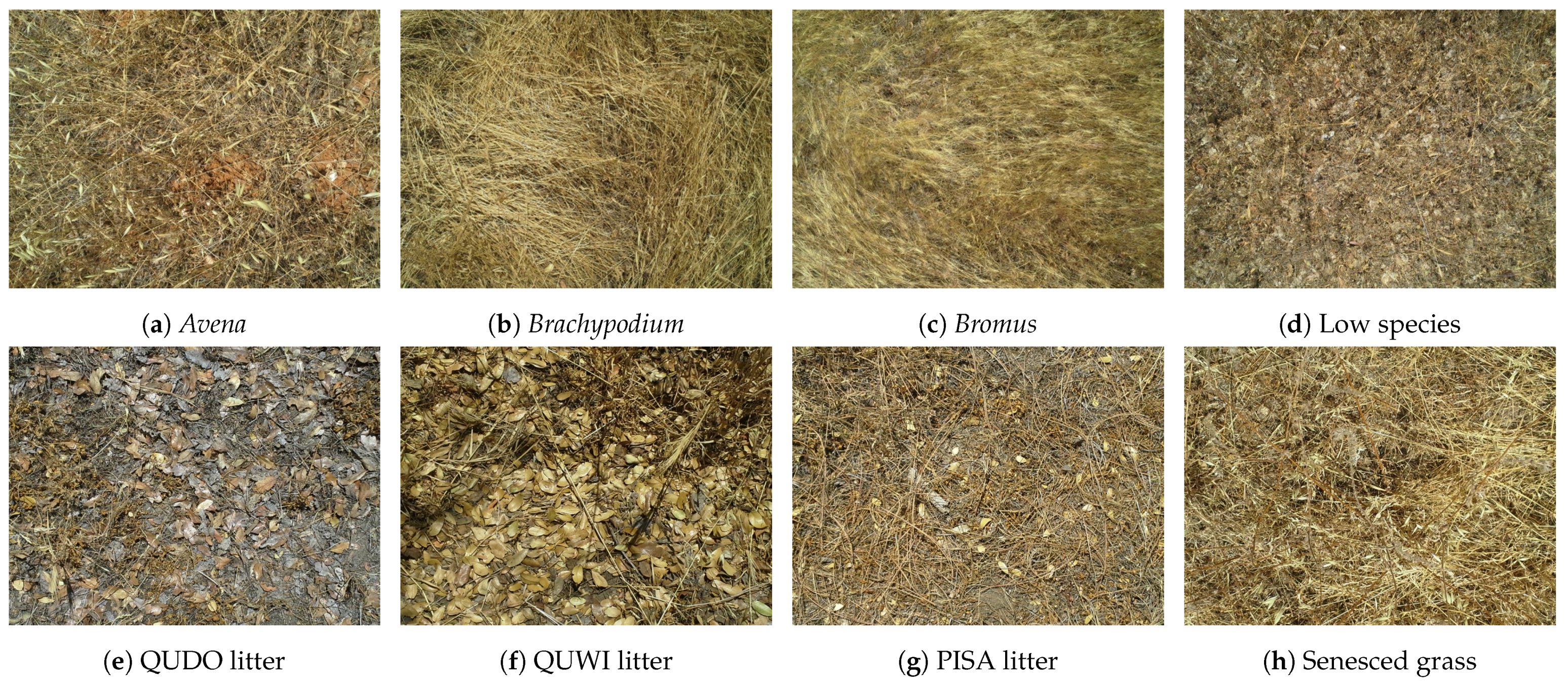
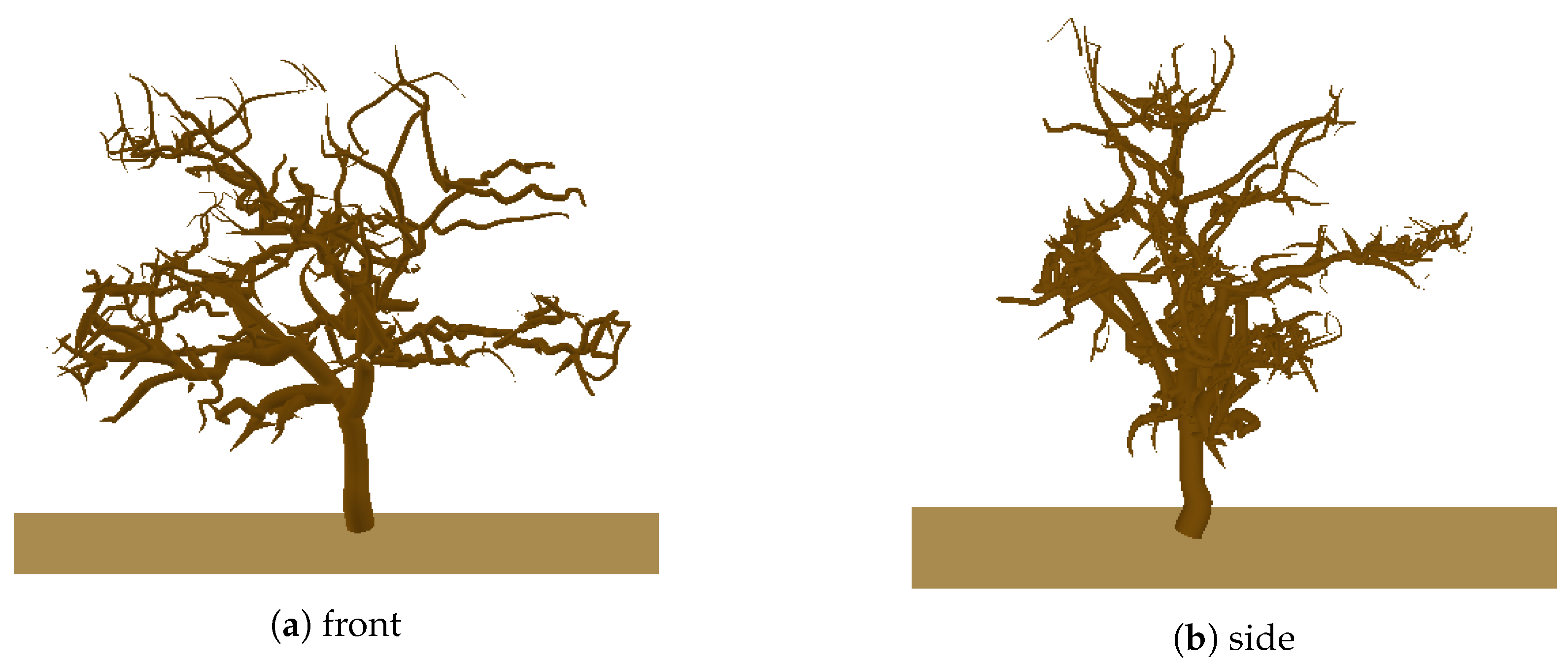
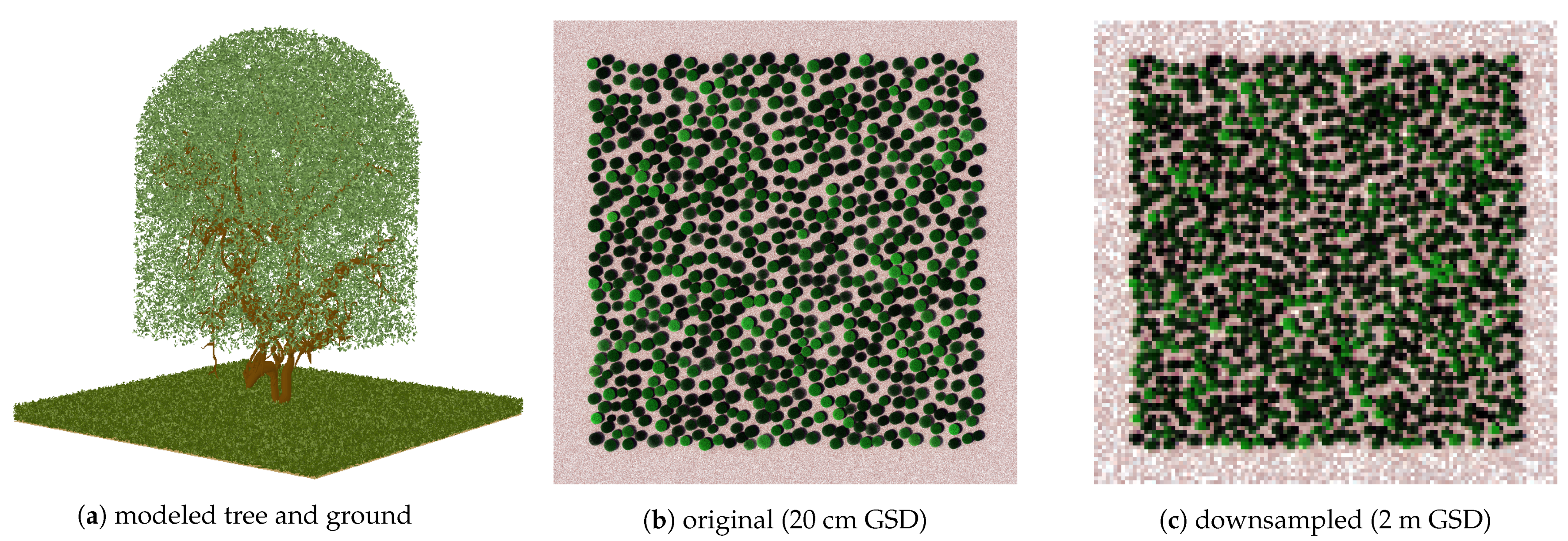



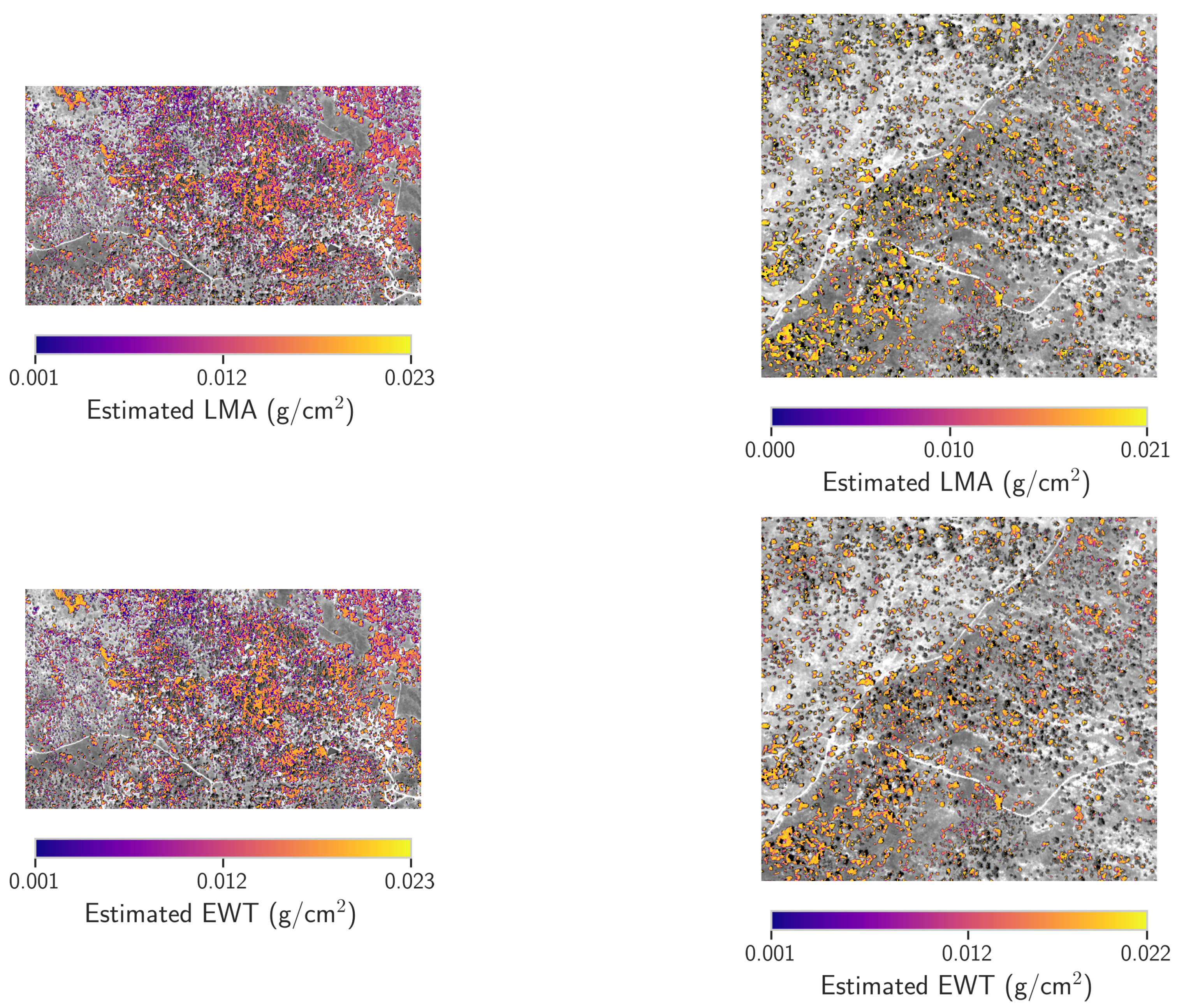
| Site | Crown Height (m) | Total Height (m) | Crown Diameter (m) |
|---|---|---|---|
| TZ | 10.4 (14) | 14.5 (14) | 8.2 (14) |
| SJER | 7 (160) | 8.6 (162) | 10.1 (16) |
| Sample No. | Min. | Max. | Mean. | |
|---|---|---|---|---|
| EWT (g/cm) | 11 | 0.011 | 0.018 | 0.013 |
| LMA (g/cm) | 11 | 0.009 | 0.015 | 0.011 |
| Value | Comment | |
|---|---|---|
| Tree characteristics | ||
| Crown diameter (, m) | 6 () 2 () | normal distribution : mean; : scale |
| Height below crown (m) | 1.8 | |
| Crown height (m) | 7.6 | |
| Crown shape | semi-ellipsoid | |
| Empty voxels (%) | 60 | |
| 3D NPV | modeled | from lidar data |
| Tree LAI (m/m) | 2.6–7.7 | uniform distribution |
| Leaf characteristics | ||
| ALA (°) | 55–65 | uniform distribution |
| EWT (g/cm) | 0.002–0.025 | uniform distribution |
| LMA (g/cm) | 0.002–0.025 | uniform distribution |
| Understory characteristics | ||
| LAI (m/m) | 0.7 | |
| LAD | spherical | |
| EWT (g/cm) | 0 | |
| LMA (g/cm) | 0.01 | |
| soil reflectance | brown loam | from DART mineral database |
| Structural Elements | SFR–Reference | Variation |
|---|---|---|
| 3D NPV | none | imported from lidar data |
| canopy height (m) | 9.4 | 12.6 |
| ground modeling | Lambertian surface (soil + herbaceous layer) | Lambertian surface (soil) + 3D herbaceous layer |
| crown shape, leaf distribution | ellipsoidal, homogeneous | semi-ellipsoidal, heterogeneous |
| empty voxels (%) | 0 | 60 |
| SFR | DETAIL | TZ | SJER | |
|---|---|---|---|---|
| Scene parameters | ||||
| Ground reflectance (Lambertian) | brown loam + herbaceous layer | brown loam | Avena | QUDO litter |
| Brachypodium | QUWI litter | |||
| Bromus | PISA litter | |||
| low stature species | senescent grass | |||
| 3D herbaceous layer | no | yes | no | no |
| Cell dimensions (m) | 0.4 × 0.4 | 0.4 × 0.4 | 0.4 × 0.4 | 0.4 × 0.4 |
| Scene dimensions (m) | 9 × 9 | 9 × 9 | 13 × 13 | 16 × 16 |
| Solar elevation (°) | 75 | 75 | adapted to image acquisition time | |
| Tree structural parameters | ||||
| Crown shape | ellipsoidal | as per Figure 4a | ellipsoidal | ellipsoidal |
| Crown diameter (m) | 6 | 6 | 8.2 | 10.1 |
| Tree height (m) | 9.4 | 6.3; 9.4; 12.6 | 14.5 | 8.6 |
| Crown height (m) | 7.6 | 5.1; 7.6; 10.1 | 10.4 | 7 |
| LAI (m/m) | 0.3–4 | 0.3–4 | 0.3–4 | 0.3–4 |
| ALA (°) | 55–65 | 55–65 | 55–65 | 55–65 |
| Empty voxels (%) | 0 | 60 | 0 | 0 |
| 3D NPV | no | yes | no | no |
| Leaf biochemical parameters | ||||
| EWT (g/cm) | 0–0.025 | 0–0.025 | 0–0.025 | 0–0.025 |
| LMA (g/cm) | 0–0.025 | 0–0.025 | 0–0.025 | 0–0.025 |
| Structural parameter N | 1.5–2.1 | 1.5–2.1 | 1.5–2.1 | 1.5–2.1 |
| Hyperparameter | Values |
|---|---|
| minimizing function | mean squared error; mean absolute error |
| number of estimators | 50; 112; 175; 238; 250 |
| maximal depth | 10; 20; 30; 40; 50; 60 |
| min. samples for a split | 2; 5; 10 |
| min. samples for a leaf (input %) | 10; 10; 10 |
| Wavelength | LAI | LMA | EWT | ALA | N |
|---|---|---|---|---|---|
| 1.1 m | 0.13 | 4.8 | 0.52 | 0.90 | 0.12 |
| 1.7 m | 7.7 | 4.8 | 1.6 | 0.43 | 0.59 |
| 2.05 m | 1.2 | 1.3 | 4.1 | 1.8 | 0.10 |
| g/cm | Train | Test | Application | |||||
|---|---|---|---|---|---|---|---|---|
| (RMSE) | RMSE | R | RMSE | R | RMSE | R | ||
| synthetic image | ||||||||
| 0.75–2.4 m | LMA | SFR | 11 | 0.98 | 25 | 0.88 | 35 | 0.81 |
| DETAIL | 12 | 0.97 | 26 | 0.87 | 21 | 0.91 | ||
| EWT | SFR | 10 | 0.98 | 22 | 0.91 | 19 | 0.92 | |
| DETAIL | 10 | 0.98 | 21 | 0.91 | 19 | 0.93 | ||
| 1.5–2.4 m | LMA | SFR | 11 | 0.97 | 22 | 0.91 | 19 | 0.93 |
| DETAIL | 11 | 0.98 | 24 | 0.90 | 19 | 0.94 | ||
| EWT | SFR | 11 | 0.98 | 22 | 0.90 | 19 | 0.93 | |
| DETAIL | 11 | 0.98 | 22 | 0.91 | 19 | 0.93 | ||
| AVIRIS-NG images | ||||||||
| 1.5–2.4 m | LMA | TZ | 16 | 0.96 | 32 | 0.80 | 29 | 0.26 |
| SJER | 15 | 0.96 | 30 | 0.83 | ||||
| EWT | TZ | 16 | 0.95 | 33 | 0.79 | 28 | 0.31 | |
| SJER | 16 | 0.95 | 32 | 0.81 | ||||
Publisher’s Note: MDPI stays neutral with regard to jurisdictional claims in published maps and institutional affiliations. |
© 2021 by the authors. Licensee MDPI, Basel, Switzerland. This article is an open access article distributed under the terms and conditions of the Creative Commons Attribution (CC BY) license (https://creativecommons.org/licenses/by/4.0/).
Share and Cite
Miraglio, T.; Huesca, M.; Gastellu-Etchegorry, J.-P.; Schaaf, C.; Adeline, K.R.M.; Ustin, S.L.; Briottet, X. Impact of Modeling Abstractions When Estimating Leaf Mass per Area and Equivalent Water Thickness over Sparse Forests Using a Hybrid Method. Remote Sens. 2021, 13, 3235. https://doi.org/10.3390/rs13163235
Miraglio T, Huesca M, Gastellu-Etchegorry J-P, Schaaf C, Adeline KRM, Ustin SL, Briottet X. Impact of Modeling Abstractions When Estimating Leaf Mass per Area and Equivalent Water Thickness over Sparse Forests Using a Hybrid Method. Remote Sensing. 2021; 13(16):3235. https://doi.org/10.3390/rs13163235
Chicago/Turabian StyleMiraglio, Thomas, Margarita Huesca, Jean-Philippe Gastellu-Etchegorry, Crystal Schaaf, Karine R. M. Adeline, Susan L. Ustin, and Xavier Briottet. 2021. "Impact of Modeling Abstractions When Estimating Leaf Mass per Area and Equivalent Water Thickness over Sparse Forests Using a Hybrid Method" Remote Sensing 13, no. 16: 3235. https://doi.org/10.3390/rs13163235
APA StyleMiraglio, T., Huesca, M., Gastellu-Etchegorry, J.-P., Schaaf, C., Adeline, K. R. M., Ustin, S. L., & Briottet, X. (2021). Impact of Modeling Abstractions When Estimating Leaf Mass per Area and Equivalent Water Thickness over Sparse Forests Using a Hybrid Method. Remote Sensing, 13(16), 3235. https://doi.org/10.3390/rs13163235









